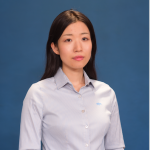Home University: Nagoya University
Field of Study: Medicine
Status: B3 Expected Graduation: April 2021
Research Host Lab: Prof. Gang Bao, Department of Bioengineering
Why Nakatani RIES?
My major goal is to become a researcher in a medicine-related area and work as part of a multinational team on cutting-edge topics. I am particularly interested in areas related to public health and difficult-to-cure diseases. To pursue each of these goals, I believe it is essential to acquire the skills and knowledge needed to collaborate with researchers from other countries. During this program, I would like to gain these abilities through exposing myself to the high-quality research and working in a diverse environment.
Also, I would like polish my English because English has now become the common language in science fields. Moreover, I am looking forward to meeting and sharing ideas with other participants since most of them are different major from me and it must be fascinating to exchange opinions about the research in which we are going to participate.
Goals for the Summer
- Acquire research techniques as much as possible.
- Exchange opinions with other fellows and people working in the lab (not only about research topics but anything such as global issues).
- Obtain good understanding about multi-ethnic environment.
- Travel around Texas and try the local food and beverage.
Excerpts from Tomo’s Weekly Reports
- Week 01: Arrival in the U.S.
- Week 02: First Week in My Research Lab at Rice
- Week 03: Interview with a U.S. Researcher
- Week 04: Reflections on English Language & Life in the U.S.
- Week 05: Research in the U.S. vs. Research in Japan
- Week 06: Final Week at Rice & Research Poster Presentation
- Week 07: Visit to Lehigh University and Return to Japan
- Final Report & Tips for Future Participants
Week 01: Arrival in the U.S.
At the opening ceremony in Tokyo, it was a great opportunity to listen to the guest speakers. “Life Science as a Major Agenda for 21st Century” by Prof. Shinichi Nishikawa was most impressive for me. He told us his anticipation of this century, what our society is going to be like, and what science is going to be like by describing the stream of science history from the 16th century to now. It was very interesting and inspiring to think about where we are and where we are going in the context of history. He did not mention anything directly related to this program, but I would like to put it as the most helpful session as it reminded me of the excitement of being in the life science field and my upcoming research at Rice University.
This is not my first time in the U.S. as I studied at the University of Illinois for one year. So, at the airport, I was not crazily excited about just being in the U. S. Honestly, I almost felt numb because of exhaustion and my heavy luggage. After sitting for a while waiting for the shuttle, however, the smell from the coffee shop caught my nose and brought me back to the University of Illinois. My initial reactions were mostly what I expected.
However, after that, things seemed so strange and new to me. The last time I came to the U.S. as an exchange student (not a tourist), I had to be pretty independent and had to arrange everything by myself. I had to decide which dorm I should stay, had to get my insurance and flight ticket, keep an eye on the schedule of the student orientations and so on… I have also been to other countries than the U.S. as a student to learn their language for a short-term. Mostly, the dorm or the place you stay does not look very attractive, and you have to struggle with the complicated orientations and documents on your own, where you do not know anybody. So, I automatically expected the same thing this time. I knew that this program generously let us stay at a pretty hotel, but I assumed that after the airport or check-in, I would have to repeat the same struggle that is pretty familiar.
So, I was really surprised when I realized I did not have to make the usual efforts for survival like getting food and water or finding out which orientation I needed to take. I sometimes still cannot believe that everything is well-organized and we are so protected and taken care of so well. I really appreciate this program which let me concentrate on studying and also gives me so many opportunities to learn and think about my future career, but I still cannot stop feeling strange yet.
The session by Prof. Kono was most helpful for thinking about my future career. Since before this program, my career plan has been going to a graduate school in the U.S. though, so the detailed information of what it is like to be a Ph.D. student and what kind of career you could pursue after Ph.D. gave me a more clear picture. Also, while I was attending Sarah’s orientation about intercultural communication, I found an interesting fact about myself. I noticed that I myself was a little confused about how I should behave during the orientation. Even though we were in the U.S. and Sarah encouraged us to speak up and interact with her, we- Japanese fellows- basically spoke (and speak) Japanese to each other and behaved in our way. If I had been with American or international students and a lecturer had encouraged me to speak up, I would have done it more obviously.
However, we were all (except Sarah and Savannah) Japanese and a kind of a closed group, so it was a little tough to speak up and obviously stand up alone, especially when the other people do not.
- It is not just about being the leader, or first person to step away from the pack and try something new. All leaders need a first, and second, follower too. This video may be interesting for you to watch and it highlights the power of the first, and second, follower.
- It may also be helpful for you to speak with the other Japanese Fellows and ask if there are certain times during the day or evening at the hotel where you might all agree to only speak in English. This can be helpful as you can support each other as you speak English in a ‘safe’ environment with your friends and it may also be easier to speak about various experiences you are having in the U.S. or your research in English. That can also help open up your ‘closed’ group in a supportive and encouraging way.
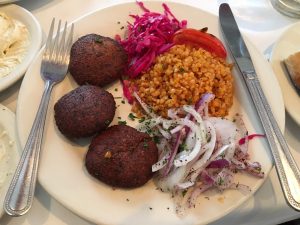
This weekend, I went to Rice Village with other Japanese Fellows and Natsumi who study at Prof. Kono’s lab and her boyfriend. I was very happy to have Turkish food at a restaurant called “Pasha”, which Ms. Aki recommended. I love eating foreign food and I often go to Turkish restaurants and Indian restaurants. Following Sarah’s tip against homesickness, that is “Do what you do at your home”, I did what I usually do in Japan. Things seem going well so far.
Question of the Week
Why is coffee here is so weak? When I order an espresso, I usually get the normal coffee I expect.
- This is a sign of probably not going to the best coffee shops, unfortunately. There are some really, really good coffee shops in Houston where you will find perfect cups of coffee (though maybe not as good as our own coffee-master Ishizawa-san).
- Check out some of these listings and, once Harvey has passed, maybe you can seek out the best espresso in Houston!
Preparing for Research in the U.S.
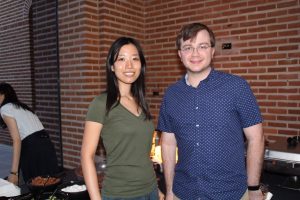
Since I knew that the field I was going to step into during this program was not exactly what I study in my home university, I decided to do as much as possible to prepare for research before I leave Japan. I sent an email to my host professor and asked him about what I might be doing at his lab and also about my mentor. He was very kind to send me a few of his articles so that I can acquire basic knowledge of what they do at his lab. Also, he told me my mentor’s name and his email address, so I e-mailed my mentor to ask about more details of the research and what else I should do to be useful besides reading the professor’s articles. Even though my mentor said the articles were enough as a kind of pre-assignment before the program, I bought some Japanese textbooks about the research topics and the techniques I might need.
In addition to this technical stuff, I hung out with my friends and visited my family to say goodbye for a while. It was not very easy to arrange my schedule while getting ready for the trip because there were so many things to do like getting prescription drugs, buying sunscreens, extra clothes for changeable weather and packing, and so on… But I think it is worth it, in sptie of my sleep-deprived eyes and fatigue. I believe that just knowing that there are the people I care about and they also care about me will boost my energy when I have a hard time.
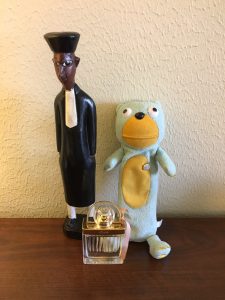
To the future Japanese fellows, if you do not think you are familiar enough with the field of your lab, I would recommend getting at least one Japanese textbook related to the topics in Japan. It would probably hard to get a Japanese-written textbook of your specific research topic in the US, and it is not so easy to learn totally new things in a foreign language, based on my experience of learning French in English. I also highly recommend spending some time with your friends and family because you need to control your mind and keep your motivation without getting homesickness, for best work at the lab. It might be a good idea to bring your lucky charm or something you use at home.
Week 02: First Week in My Research Lab at Rice
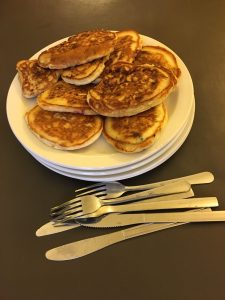
On my first day, I met my mentor Alen and the Senior Lab Administer, Amy. They seemed very kind, and we talked about working hours, their research topics and my background. The lab members usually work 9 to 6, but my working hours will depend on my mentor’s schedule and also vary by day. After that, Alen gave me a quick tour of the lab and showed me the machines we were going to use. I learned that there were two main topics in Prof. Bao’s lab: genome editing using CRISPER/Cas 9 and nanoparticles for imaging, and I am going to deal with nanoparticles. It was probably because that was the beginning of the semester, but there were only a few people at the lab. Monday, there was a general lab meeting. I met Prof. Bao for the first time, and he generously let me introduce myself to the other members. This lab is relatively big, there are about 16 people in total.
My mentor, Alen, seems nice. He is a second-year Ph.D. student and started working at this lab 6 months ago. He spent 5 years working as an engineer in a company and came back to grad school. He generously invited me to dinner with him and his girlfriend. Although we could not make plans for the first weekend because his dog got sick and he had to take care of him, I hope I would have some time to hang out with people in my lab.
Prof. Bao seems very busy, and he does not come to the lab so often, but he is very helpful, for example, when I asked him if I could audit his class which my mentor takes, he replied right away and also introduced me to the other professor’s class about genome editing. The genome editing class was canceled this semester, but I was impressed with his support despite his tight schedule. I am thinking about making an appointment to talk with him after things go back to normal. Unfortunately, there have been a few unexpected accidents happening, so I did not spend enough time conducting the experiments during the first week. However, after talking about the issues with Sarah and Aki, who were so supportive and helpful (I appreciate their advice), and also with my mentor, Alen, I now have a clear view of the research project and feel positive.
Honestly, it was not so easy to communicate in English. The biggest difficulty was terminology. Since I received my whole education in Japanese, except one-year studying abroad, there are a lot of things whose names I know in Japanese but not in English. So, when my mentor asked me if I had ever used a centrifuge, I did not know what it was. It turned out it was 遠心分離機, and of course, I have used it at least for a few years in classes. I love Japanese as a language, and I think it is such a privilege to enjoy our literature and a bunch of collections of translated foreign literature in my mother tongue, but now I wish I had learned more of the general scientific terms in English as well. I did this in my major, but I need more in general. When I speak a foreign language, I sometimes feel as though I am breathing through my ears. English is not as hard as before, since I have been learning it for years, but still, it gives me some pain from time to time as it is not my original organ to inhale and exhale.
At the poster presentation talk, I learned basic tips to make a good research poster. The presenter showed us bad examples and good examples. It seemed that making a convincing and attractive poster takes a long time, so I searched the internet to get more clues. For example, these websites below seem helpful. They overlap with the lecture to some extent, but I think they will be useful when I make my poster because they have some new ideas as well as repeat the relevant facts.
- Stanford University: Making a Good Poster
- MIT: Make a Great Poster (PDF)
- Also see our website page on Presentation and Poster Development resources
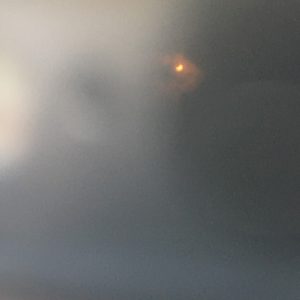
On Monday, I saw the solar eclipse with my mentor, Alen, and his friend. We went to the engineering quad because he heard that the physics department had some extra glasses, but at the quad, there were already so many people, and obviously, the glasses were not enough. So, I was thankful that I got my glasses for the eclipse from the Nakatani RIES Program beforehand. I lent them to others too. The eclipse itself was mysterious and made me wonder what ancient people thought when they saw it. Also, I thought back to the last time I saw this kind of phenomenon, that was in my high school in Japan as far as I remember. I asked myself, “what will I be when I see this next time?” It came much earlier than expected but it was good to look back.
Research Project Update
Our research topic is the loading of nanoparticles into Jurkat T cells. To make this clearer, I would like to explain the terms. Jurkat T cells are human T lymphocyte cells, which play a significant role in our immune systems such as attacking tumor cells or infected cells with viruses. Nanoparticles are particles between 1 and 100 nanometers, and because of their size, they have a lot of unique properties. Nanoparticles are a relatively new but very promising field, especially in medical treatments. In my research, I am going to put super paramagnetic iron oxide (SPIO) nanoparticles into T cells so that we can track the T cells with magnetic resonance imaging (MRI). Our goal is to find the best length of time to create the T cells loaded with a high enough amount of nanoparticles for imaging. Analyzing nanoparticle uptake by flow cytometry is only the first step, but if you could see and track T cells, and if you could make the T cells capable of killing cancer cells selectively, it would help advance cancer therapy significantly.
In the project, we put the Jurkat T cells into 4 different groups by with/without TAT peptide, the peptide which helps cell uptake of nanoparticles, and with/without nucleofection; the technique which opens the pores through the cell membrane to let nanoparticles enter. After nucleofection is completed, we incubate the cells with the nanoparticles in 5 different time length
(4, 8, 24, 48, and 72 hours). As an analysis step, we use dead cell staining which shows the ratio of dead cells to find out the effects of nucleofection on cell viability, and then we sort the T cells with flow cytometry.
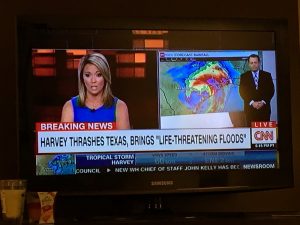
It was hard to plan the experiment because of Hurricane Harvey is coming now, but my mentor said if everything were goes well, we would finish all the experiments around the end of the 3rd week. I would like to add detailed time line later.
I do have one question about my research: Even though I heard that what we are doing is mainly for MRI imaging and tracking, is there any chance to make it for therapies too? I read an article which uses the nanoparticles for multiple tasks including cancer detecting and treatment. So, I am wondering how difficult it is to make nanoparticles for multiple uses.
- Nanoparticles can be used for many different things and there are applications in bio, chemical, physics, electrical, environmental, and many other fields. If you search Google for nanoparticle + a field/area you will likely find many interesting articles.
- A good way to do this easily (and not end up with just a lot of technical research papers that are hard to understand) is to search in a more general scientific magazine such as Science. This magazine introduces cutting-edge research for a more interdisciplinary, general audience and links back to the peer-reviewed research papers for people that want to learn more about the in-depth, technical research.
Week 03: Interview with a U.S. Researcher
For this week’s assignment, fortunately, I had a chance to talk with Prof. Bao, who is the professor of my lab and also one of the top researchers in the field of nanomedicine. At first, I hesitated a little to ask him about the interview, because I knew he was very busy traveling a lot for conferences and seminars, and especially because it was just after the hurricane. I was afraid that my email might be inappropriate if he was in trouble such as if he had no power or no wi-fi. However, it turned out that his house was had almost no damage and the interview with him went fantastic. So, for the future fellows, if you have the same assignment, I highly recommend contacting the person you want most to talk with.
Prof. Bao’s career is fascinating. He changed his major at least twice. After getting a bachelor’s degree in Mechanical Engineering and a Master’s degree in Applied Mathematics at Shandong University, China, he was accepted into an Applied Mathematics program at Leigh University, the U.S. and got his Ph.D. there. Then, because of the contract of his scholarship during his Ph.D. program, he moved back to China and worked as a post-doc at Beijing University, China for about one year (1987-1988). Even though he was at the best university in China, he felt that his country at that time was far behind the U. S. in finance, technology, and information. (Since that was the age before the Internet, it took him two years to get an article after its publication.) Also, there were some political issues as well. While he was working at the Beijing University, he witnessed the movement seeking for more freedom especially among young students and felt something would happen soon. One year later, from the U.S., he found he was right when Tiananmen Square Massacre took place on June 4th, 1989.
For a better research environment, he decided to go back to the U.S. He worked as a post-doc in the Materials Department at Cornell University. At first, he stepped into the Materials field from Applied Mathematics mainly for more job opportunities, but also, meeting the great professors in this field made him consider becoming a professor. Six years later at Cornell University, there was a turning point in his career. Through interaction with other researchers and his deep insight, he made up his mind to change his major into bioengineering! As you know, if you are a professor in an American University, you have a one year sabbatical after working six years. So, he spent his sabbatical learning bioengineering from scratch, which I thought was very impressive. As the last step, soon after back to Cornell, he got an offer and moved to John’s Hopkins University, which is one of the most prestigious schools especially in the medical field. That was how he finally came to his current field, medical engineering.
It was surprising that he had such a flexible career path. When he goes to a new place, he makes friends with the people there and interacts with them. It is how he absorbs novel ideas and keeps challenging new topics. It is hard to get out of your comfort zone, especially if you have already built up a good status. So, I think his flexibility and challenging spirit should be highly admired.
I also asked him how he got interested in his current research topics; genome editing with CRISPER/Cas9 and Nanoparticles.
In 2000, President Bill Clinton advocated nanotechnology development and stated the government’s full support of nanotechnology. Many grants were released one after another. In that “nano-tech” trend, Prof. Bao, who was at the Georgia Institute of Technology, got two major grants for nanoparticles research and genome editing and launched his new projects. Even though he was excited about the novel technology of genome editing, nobody in his lab knew how to conduct the brand-new techniques of genome editing (ZFN). He said it took almost one year for them to learn the method. Later, as new ways came out, his lab introduced the latest technology again and again, and now they work on genome editing techniques with CRISPER/Cas 9 for single gene diseases therapies. According to him, their research has come close to clinical applications, and he expects to achieve this success within two years. Besides, when he moved to Rice University, he started to collaborate with the MD Anderson Cancer Center, which is the most major cancer institute in the U.S. And that is how he launched nanoparticle- research for cancer immunotherapies.
In addition to his impressive career path, he told me more about the big picture of his research projects. He thinks these are the two biggest biology discoveries in this century: genome editing and cancer immunotherapy. And he is working on both. His view is that genome editing is already pretty mature and almost ready for clinical application, while nanoparticles are still its infancy but it has tremendous potential. Honestly, I had complicated feelings when I found that I was going to be doing resarch dealing with nanoparticles, not genome editing with CRISPER because everyone (maybe not everyone, but many of my friends who study biology anyway) got jealous when I told them I was going to the lab using CRISPER. However, for the past few weeks, reading a lot of articles about nanoparticles and Prof. Bao telling me how nanoparticles could enhance the latest immunotherapy, now I feel very honored to participate in this field. Even just as a tiny ice crystal of this huge glacier, I am grateful to be part of it.
Research Project Update
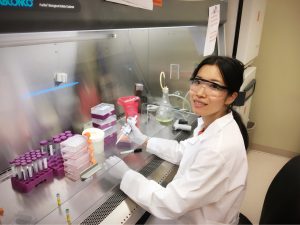
On Tuesday, I went to the lab for the first time after the hurricane. As my mentor had warned me me, all of our cells were dead. My mentor and I confirmed that they were small, dark, and aggregated. So, we incubated new T-cells again, and we are waiting for them to grow in enough numbers for our experiments. On Friday, hopefully, we can start the experiments which take three days for another incubation. Unlike other Physics, Computer Science, or Chemistry major students, I need to be patient till our cells grow. However, I have kept reading related articles and already started the draft of my poster. I noticed that my understanding of my topic was gradually getting better, and after talking and asking questions to Prof. Bao, I feel I got a much clearer image of this research area. Also, on Tuesday, when he came to try my new espresso maker, another Japanese fellow, Shohei, and I happened to find that we were working on the same topic (nanoparticles) from the different aspects (his: physics and material, mine: biology and clinical application). So, we had a deal that we would help each other by giving the knowledge which one of us has, and the other doesn’t. He explained about the “quantum size effects,” which had bothered me for the past two weeks. In return, I gave him some examples of clinical applications of non-organic nanoparticles. I believe I could learn deeper about my topic with my new physics teacher.
Question of the Week
Why do TV commercials in the U.S. tell us more drawbacks and side effects than effects of the medicine itself? Do people find it more reliable if they show them all the possible concerns? Or, is there any laws about it? I doubt many people would like to try a pain relief medicine for arthritis by taking the risk of severe allergic reaction, tuberculosis, and cancer.
- This is because of laws regarding how prescription medicine can be marketed in the U.S. The U.S. is actually one of just two countries in the world that allow direct to consumer marketing of prescription drugs. Over time, there were specific laws develop to protect consumers in terms of how drugs were marketed and these warnings of side effects are one of them.
- The commercials you see on TV that are advertising medicine are all for prescription medication that drug companies have made major investments in developing. They advertise on TV hoping that patients will go see their doctor and ask them about the specific brand/type of medicine that saw on the commercial. The more prescriptions doctors write for that particular medication the more money the drug company will make to recoup its investment in research and development (and make a profit).
- However, there are strict laws about how prescription medication can be marketed and that is why at the end of these commercials they quickly say all the possible side-effects or counter-indications. Sometimes these will be printed in very, very tiny print at the bottom of the screen and when you are prescribed this brand name medication there will be a sheet included with a lengthy description of all its possible side effects.
- After a certain period of time all medications have to change from being brand name and trademark protected (meaning the company makes a profit on each sale) to become generic medication meaning that they are prescribed using the formulary name and the company no longer has a monopoly on its production or marketing. This means the potential profit goes down as other drug companies can produce the same pill and sell it under the generic name. For example, Synthroid vs. Levothyroxine for thyroid conditions. Drug companies can still make a profit off of selling generics and some doctors/patients will still request the original/brand name, but the potential profit margin for generic medication is less due to great competition.
- So, drug companies will ‘re-forumulate’ the original medication to make it an extended release, or add in something that has a slight additional benefit, trademark that ‘new’ drug and market it anew. For example, for allergy medication it was first marketed as Allegra then Allegra-D, then Allegra-…. You get the picture. Now Allegra is no longer a prescription medication but can be purchased over-the-counter at any pharmacy without a doctor’s written prescription.
- FDA: Drug Marketing, Advertising and Communications
- Wikipedia: Pharmaceutical Marketing
- Hidden in Plain Sight: Marketing Prescription Drugs to Consumers in the 20th Century
- US Drug Marketing: How Does Promotion Correspond with Health Value
- Direct to Consumer Drug Marketing is a Scandal. Can the FDA Fix It?
Week 04: Reflections on English Language & Life in the U.S.
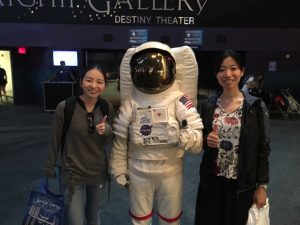
As I described in the previous weekly report, I have had a lot of difficulties using English. I wish I could say, “I faced so many problems, but after three weeks, I am totally fine.” However, for the future participants, I think I should be honest about this point. It is true that I feel I am getting used to the scientific terms in this field (nanotechnology, cancer, nanomedicine and so on), but I still find myself in trouble many times in a day, especially when I talk to people. It is hard to keep talking with confidence if someone makes a confused face when you speak to them. You feel like you are saying something inappropriate and tend to hesitate to go on. I have recently found that maybe it is just their habits, like some people frown while they are thinking, or maybe because of my volume in a noisy room. That is the sample size dogma: if the sample size is too small as a few people, you cannot reach a rational conclusion based on it. I am grateful that I took “Introduction to experimental psychology(PSYC103)”, which has kept me from being irrational and feeling miserable. So, I have decided not to care about it so much and tried to talk louder and more slowly. Also, it is impossible to master a foreign language perfectly within a month, so I think I have been doing well enough. As long as you show your passion, the people in your lab are willing to help you, so the key is to keep your motivation for communication.
To convey my ideas more clearly, I usually bring something written down or images from the internet when I ask some questions in the lab. Since the time I can stay here is very short, I think we should try not to give up explaining in English but also to use alternatives like images or graphs.
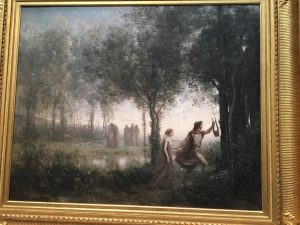
Also, to improve speaking and to interact with local people, I hung out with a few Rice students I met outside of the lab. I make friends with Pam, who studies Art at Rice University and works in the Museum of Fine Arts Houston. On Sunday, she gave me a tour of the museum and explained the background of the works. It was fascinating to have my private museum guide because I could stop her anytime and ask questions. She was an excellent guide. She can tell you not only the techniques used in a painting but also the history of their culture at that time and even how the museum bought the work. Her job is mainly collecting data to judge if the museum should purchase an art work or not at the auction.
Research Project Update
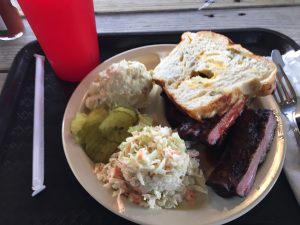
Last week and this week, there has been a great advancement in our project. Since our cells were finally ready, (they reached enough numbers for conducting the experiments), we were able to begin the primary procedures and have almost finished indeed! The aim of our study is loading I the nanoparticles into the T cells as much as possible unless there are no drawbacks to the cells. So, we conducted nucleofection, which is the technique making pores electrically on the cellular membrane so that little substance can enter into the cytoplasm, and left the cells in the solution which contains the nanoparticles. After different time points, (2h, 4h, 8h, 12h, and 72h), we used flow cytometry, which allows us to detect the size and internal structure of cells. By measuring fluorescent intensity, we can see how many T cells have nanoparticles inside because we put the layer of fluorescent staining around the nanoparticles. This week, we are going to analyze the data and see the relationship between the number of nanoparticles and incubation time considering other factors such as viability. Also, if we have enough time, we might be conducting another technique to see how many nanoparticles a single T cell has.
Incubation time is so important since our research is basically for visualizing engineered T cells for cancer immunotherapy. In such therapies, some amount of blood is taken from a patient, and the modification such as introducing engineered anti-cancer T cells and loading nanoparticles for tracking, the blood is injected back into the patient. Thus, we need to know how long the patient has to wait, as the shorter, it takes, the better for the patient, but we also need to put enough amount of the nanoparticles.
In addition to tracking T cells for immunotherapy, iron oxide nanoparticles, in general, has enormous potential for medical use. Iron oxide nanoparticles could be utilized for drug delivery, MRI imaging during surgical operations and inflammation or lesion detection. For these treatments, our current topic could bring useful knowledge as well as they require cellular uptake of nanoparticles anyway.
Question of the Week
Where does a garbage disposal of the kitchen sink go after the sink? Is it directly connected to the sewage? I think it is an excellent tool, and I wish I could have in Japan.
- Yes, you are correct, it goes into the pipes and down into the wastewater treatment system. Because it is supposed to grind things up so well, the small food and other particles can be filtered out of the water system at the wastewater treatment plant and then disposed of in other ways.
- However, there are certain things you should not put down a garbage disposal, such as cooked rice. Because the rice grains are already so small the garbage disposal won’t grind them up properly and the may get stuck and clog up your pipe as they keep expanded due to the water that is draining down. Used coffee grinds also shouldn’t be put down a kitchen sink/garbage disposal for the same reason.
- What You can Put Down Your Garbage Disposal
- Top 5 Tips to Keep Your Garbage Disposal Running Right
Week 05: Research in the U.S. vs. Research in Japan
As we were told during the orientation in Tokyo and Rice University, labs in the U. S. seem to be more flexible. People come to the lab at different times and work in their own style. Also, all of the lab members respected the PI, Prof. Bao a lot, but it is not hierarichical. Among the graduate students and other post-doc, they seem more equal than Japan probably because there is less impact of order by age.
They usually call each other by their first name. They work in their own way at different topics at different times. When they collaborate, they work together, but otherwise they basically work by themselves. So, I found that they are less interactive than the people at the lab where I did another summer research program in Japan. I have not seen them talking about their research topics a lot except during the lab meeting. Since what they work on is so diverse, it might be difficult to go into another person’s topic. Or maybe because there are two main topics in my lab, and I have been working in a relatively new and smaller part.
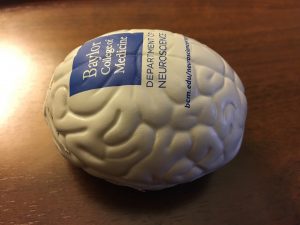
What I believe is valued in terms of academic research in the U.S. is active aggressiveness and competitiveness. You have to show your enthusiasm to your PI, TA, and your potential mentors. This week, I met a few people who came in for a rotation in my lab. I had met one of them before that, because he came to listen to the general lab meeting and he made an appointment to talk with my mentor (I was there too). They did not mind my listening to them, so I was able to learn how people rotate in the first year of a PhD course in this academic department and how they decide on a lab. My mentor said, some professors take students only if the students wants to get into their lab as the first choice. He also emphasized that it was very important to observe the atmosphere of a lab and how people work because it is so diverse. In some labs, even a PI will do wet experiments by themselves and come to the lab every day, but in others, these things would never happen. So, it is very important to contact PIs and go to their labs and show your motivation. Of course, that kind of attitude is important in Japan too, but if you do it so obviously, it may be risky. It might be too much, unsophisticated, unharmonious or just “he or she is just not one of us.”
Following their competitiveness, I made an appointment a few times with Prof. Bao or the associate professor, Prof. Sheng, to talk with them and ask my questions. After I started to talk with Prof. Bao or Prof. Sheng by making appointments, things have become much much clear to me. They understood what I was wondering or confused about, and gave me a big picture of the research. They draw a lot of figures, put it in other words, and lead me to a better understanding. Especially Prof. Bao, whenever I talk with him, not only I get deeper knowledge, but I can also strongly believe in the research topic and feel, “Oh my goodness, this is something!” I really really appreciate the fact that he took some time just to talk with me in such a busy schedule, and gave me many useful lectures.
Week 06: Final Week at Rice & Research Poster Presentation
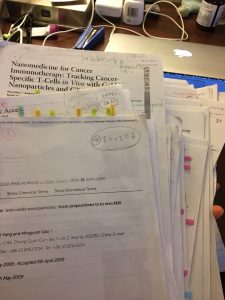
As I have already finished all the experiments before last week, I did not have anything in the lab this week. I am working on my poster and thinking about how to deliver the core ideas helped me understand better about my research topic. Since I have read so many papers (more than 30), skimming them again to pick up the ones to use in the poster was also helpful too. My mentor, Alen, checked my poster and gave me some suggestions especially about font size. Prof. Bao also checked and helped it a lot. I am thinking about asking Alen to check my presentation before the real poster session.
This is not directly related to my lab though, when I made my poster, I got a lot of help from my family, my boyfriend, and my old English teacher. I am the only life science major in my family. (My parents are linguistic researchers and my boyfriend majored in English literature. My brother is still deciding, but he is busy for the entrance exams.) So, it was a very good practice to explain the idea of my research to my parents. I believe they are the toughest (and greatest) audience. My mother says she is so proud of me for doing research in Houston, but when I go into the details, it reminded her of that she hated Chemistry in high school. (It is actually Biology, not Chemistry, Mom.) But through all the attempts to catch her attention during the rehearsal, I was able to know what people do not know about Biology and what they can understand without a lot of background knowledge.
My father does research of something between linguistic and neuroscience, so he has used an MRI and is more familiar with my topic. But his questions are also hard too. He says, “I understand most of your concepts, but why do you use this material? Are there any alternatives? Is there any specific reason to use them? Why do you use this imaging method? How about another imaging? (eg. Why MRI? How about CT scan? Why do you use iron nanoparticles? Gold sounds nice too for some reason.) After almost finishing my presentation draft with my parents, I rehearsed it again with my boyfriend whose major was Shakespere, just to make sure my poster presentation is understandable for those who do not have any knowledge of Bioengineering. I thank them for all their support through Skype despite such a time difference between Japan and the U.S.
Poster Presentation at Rice University
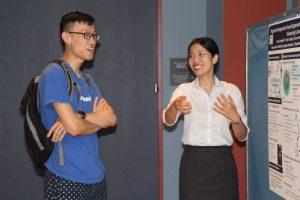
On the day of the poster session, I think I did my best despite my cold. I practiced a lot with my parents, friends and then got a final check with my mentor. Because Prof. Bao read my poster and gave me advice about it, I was pretty confident with the content. Through my poster project, I have learned so many things, but I would like to talk about three of them.
First of all, everyone has their different pace or style to participate in a poster presentation. Some people would stop me and ask questions in the middle, while others listened to me till the end. Some want it done quickly, and others always need to make sure we are on the same page.
Second, if you learn things to where you can explain the content to others who have never heard of it, then it is the best way of learning. While making the poster, I had a lot of findings of the project itself and what I understood and what I did not. Also, what I should cut off or make short. I got interested not only in the methodology of the research projects, but also the backgrounds, motivation, and future applications a lot and spent hours to understand them. So, it was pretty painful to cut off the content I finally got after reading hours and hours and the long discussion with my associate professor and my PI. Anyway, it was necessary to delete from the poster because the background was too complicated and not the project itself.
Finally, I learned the importance of cooperation. To practice our presentation, our Japanese fellows has pre-poster presentation practices a lot. Sometimes just one on one and we would give our honest opinions to each other or in other times we deliver an oral presentation (the longest version) sitting in front of the other students. Listening to the other’s presentation was very helpful to find out what I should improve, and also just interesting because they had been doing different things from mine. I appreciated their help and their willingness to help each other. Also, I am happy to hear Etsuko got the second prize for her poster. I hope my honest no-sugar-coating opinions during our practice contributed to it a little bit.
Final Research Project Update
My research topic is , “Magnetic Nanoparticle-based Approaches for T cell Targeting and Tracking In Vivo” and it is helpful for cancer immunotherapy. Fortunately, I have had an opportunity to participate in this research with my mentor, Alen, at Prof. Bao’s lab this summer. To put my topic more simply, as we use magnetic iron nanoparticles, we would like to put as many nanoparticles as possible into T cells because it will be beneficial for cancer immunotherapy.
Just in case you are not familiar with cancer immunotherapy, I would like to explain it a little bit first. In cancer immunotherapy, doctors draw some blood from a patient and take T cells, the kind of immune cells from the blood and make those ordinary T cells into modified T cells. They give the T cells a cancer-killing ability by genetic modification and tracking agents Because they want to know where the T cells go after the infusion. Anyway, they make a lot of modified, cancer-killing T cells and put them back into the patient’s body.
We use magnetic iron oxide nanoparticles for MRI, but why do we use magnetic iron oxide as the material of the nanoparticles? Why do we want to put as many nanoparticles as possible into T cells? First of all, we use iron because it is very safe. We take iron from our daily food every day. So, our body already has a system to metabolize iron naturally. That’s why iron is safe compared to other metals. Next, why as many nanoparticles as possible? Because we want to use them for MRI. MRI is an imaging method using a magnetic field, and because iron reacts with a magnetic field, the more nanoparticles T cells have, the more accurate the image will be. Also, because magnets attract iron, we can drug and keep the cancer-killing T cells around the tumor if the T cells have enough iron nanoparticles inside. And then, the T cells are going to attack the cancer cells!!
However, there has not been a enough efficient method to convert magnetic nanoparticles into T cells yet. So, our purpose is to find out the way of delivering magnetic nanoparticles into T cells with high efficiency.
To achieve that goal, to put more nanoparticles in a short time, we have been developing these methods.
As you know, iron is A metal, and it is not originally water-soluble. To make it water soluble, we put those special coating layers on the surface. Our coating layers consist of 4 layers from hydrophobic inside to hydrophilic outside layer which made from PEG. These layer enable the nanoparticles to mix with the T cells in the solution.
In addition to the coating, we used a technique called nucleofection. Nucleofection is a method making pores, holes on the cellular surface by electric current. We put T cells and our nanoparticles together into the solution and made a lot of pores on the cellular surface by nucleofection. It is done in just a few seconds, and left them for incubation at different time points like 2h, 4hm 8h, and 12h.
Also, as a part of another method to increase cellular uptake, we used Tat peptide. Tat peptide is a positively charged peptide, known to enhance cellular uptake. The detailed mechanism is still controversial, but the positively charged Tat peptide gets caught by the fluffy surface of our coating (PEG), and our nanoparticles themselves end up being positively charged. It is known when something is electrically charged, they are more likely to get into cells by endocytosis.
And as a result, we successfully observed the increase of cellular uptake by our methodat each incubation time. The red line shows far greater nanoparticle-uptake at each time point among the 4-nanoparticle group. And that red group is a group we used these 2 methods on, nucleofection, making pores techniques and Tat peptide, positively charged peptide.
In conclusion, we successfully observed that the interactive effects of nucleofection and Tat peptide enhanced the cellular uptake of the nanoparticles at different time points.
For the next step in the research, as you can see in Figure 2. the red line decreased after 8h. There are a lot of possible causes, but I think maybe it was because the concentration of nanoparticles was not enough at 8h or 12h. Because we have never had such a long incubation time, we did not notice it. But as you may know, cells grow. So, we put enough nanoparticles for 2h or 4h, but after there were so many cells at 12h, the number of nanoparticles for a single cell was maybe not enough. So, I would like to conduct this experiment with a higher concentration of nanoparticles and A longer incubation time. Also, I would like to change the fluorescent dye and negative control groups too.
The ultimate goal of this research is to develop a method of detecting and controlling the number of modified, cancer-killing T cells around the tumor. And I believe, after this approach has been completed, we can achieve even more efficient way of cancer treatment someday.
Return to Top
Week 07: Visit to Lehigh University and Return to Japan
Unfortunately, I could not participate fully in the schedule at the Lehigh University. I had to study so hard after the poster presentation because I was going to have two pathology exams just after the program. I did pretty well at these exams thanks to my hard work on the plane and the airport and the hotel.
I still feel strange about my life in Japan because it is not related to the life in the U.S. I hope I will be normal before too long.
Return to Top
Final Report & Tips for Future Participants
The most important thing I learned from the Nakatani RIES program is the importance of reaching out of your comfort zone. It was not easy to determine new knowledge, in a new lab, with new people. It was very frustrating actually. The way you are used to solving problems might not work in a new place. However, through these struggles out of my nest, I learned how to get help from others, how to show your enthusiasm, and how to make new friends and show them my appreciation. I have already written the details in my previous weekly reports, but to sum up, it was an excellent experience to learn communication and academic skills that I can use from now. If my teachers, parents, or employers asked what I learned through the program, I would like to say; I learned the importance of trying new things, keeping motivated, and always thinking about how to improve.
To the future applicants, to make your experience fruitful, the key is not to hesitate to ask help from others and keep your motivation.
Follow-on Project
As a follow-on project, I would like to share information on the Nakatani RIES program with students in my home university through the Study Abroad Office as that was how I found this program. Also, to promote participation of medical students to research field and as a result to the program, I would like to ask a friend of mine who organizes International Federation of Medical Students’ Associations (IFMSA) – Japan to put some advertisements about this program on their website or the mailing list. I would like to give a few information sessions as well to high school students or university students in my town.
Since students who come to these sessions or have access to the Study Abroad Office tend to be already open-minded and want to get out of their comfort zone and try new things, I would also like to encourage students who stay in their daily routines and have no interests in studying abroad. The other day, I found an internship brochure at the coffee shop which I have been going since this semester started. It was about two different kinds of spring internships in Indonesia, focusing on improving their education. I thought this would be a perfect place to put some advertisement of the Nakatani RIES program. Everyone has to wait in a line till your coffee is ready, and meanwhile, they are just looking around or checking their phones tiredly. So, if we put a brochure on the cashier counter of a bookstore which sells science textbooks, locker rooms or coffee shops on campus, we could get more attention from busy science students who have never thought about conducting research abroad.
